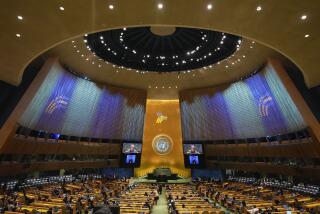PREVIEW / WORLD SUMMIT : U.N. Prepares to Shift Its Focus to Helping Children
- Share via
WASHINGTON — The United Nations says it will be the largest gathering of world leaders in history. On Saturday and Sunday, President Bush and 70 other heads of state will meet in New York for the World Summit for Children, the most publicized step so far in a five-year battle to draw attention to the issues of health and education for mothers and children.
The United States is now expected to sign a U.N. treaty at the summit that sets goals for improving the condition of children. But it will be an awkward moment, because the document will address the declining state of children in the United States as well as the starving thousands in the Third World.
The U.N. Children’s Fund (UNICEF) says 20,000 children around the world die each day from preventable or treatable cases of whooping cough, measles, tetanus, pneumonia and dehydration. Overall, the World Health Organization estimates that 150 million children will die from preventable causes in the next decade, including 4 million in the United States.
The U.S. problems, which critics say have been exacerbated by budget cutbacks, include 270,000 babies a year born with low birth weight, several U.S. cities with infant death rates comparable to the Third World and hundreds of thousands of children damaged by narcotics addiction and malnutrition.
GOAL: The most tangible result expected to emerge from the summit will be the declaration urging ratification of the Convention on the Rights of a Child, a plan adopted last year by the U.N. General Assembly after a decade of negotiations. Already, 110 countries, not including the United States, have signed the treaty. Of that number, 43 have formally ratified the document.
On Sunday afternoon, the world leaders are expected to participate in a ceremonial signing of the treaty, which calls for a series of improvements to be realized by the year 2000. Among those improvements are the reduction of infant mortality by one-third and maternal mortality by one-half, the immunization of 90% of all children, the reduction of measles deaths by 95% and bringing the rate of low weight births below 10%. The treaty also calls for access by all couples to family planning services.
OBSTACLES: Children’s program advocates say the greatest obstacle to the treaty goals is obtaining money. Ironically, the summit is being held on the same day as the deadline for congressional budget negotiators to hammer out a five-year, $500-billion cut in the federal deficit, which almost certainly will include cutbacks in all manner of social programs.
UNICEF contends that the programs outlined in the treaty to prevent child deaths and malnutrition in this decade would cost $2.5 billion per year.
“The payoff is so spectacular,” said UNICEF executive director James P. Grant. Health breakthroughs, such as the global immunization program, now save 10,000 children’s lives a day and cost less than a billion a year, he added.
The Bush Administration has been generally supportive of children’s programs, as exemplified by last year’s expansion of Medicaid funds from the coverage of 1-year-olds to all children under age 6 living in poverty. But the commitment to children has not been comprehensive or concrete enough, U.S. child advocates charge.
“We can agree to do great things for kids, but one of the biggest elements is money,” said William Scarbrough, director of research at the National Center for Children in Poverty. “We’ve seen tremendous cuts in these programs over the past ten years,” he said. “Why would we expect with a world summit that we will get money for these programs?”
More to Read
Sign up for Essential California
The most important California stories and recommendations in your inbox every morning.
You may occasionally receive promotional content from the Los Angeles Times.











